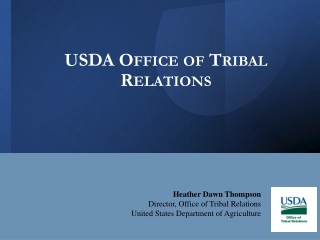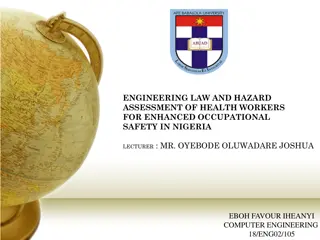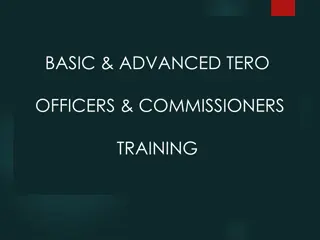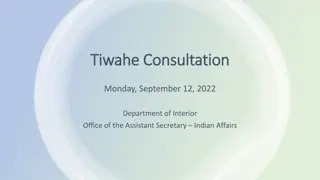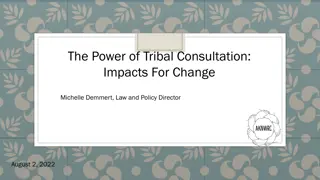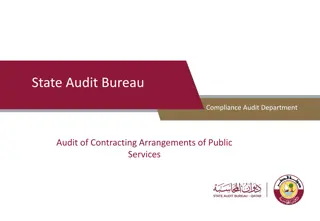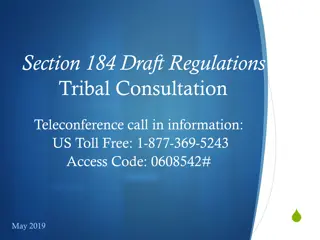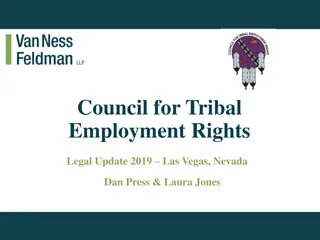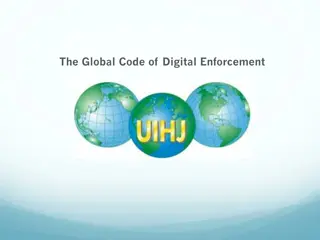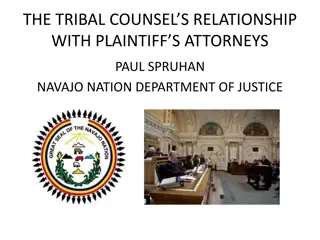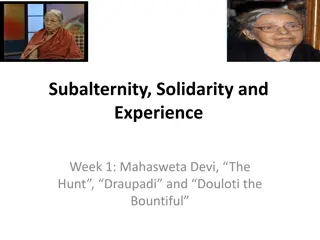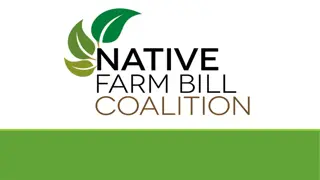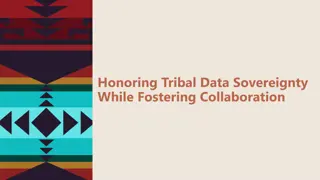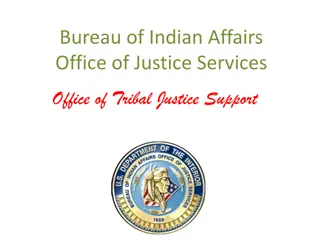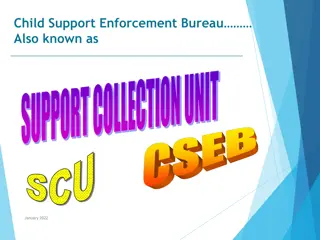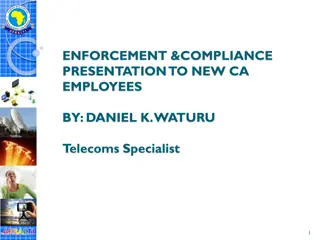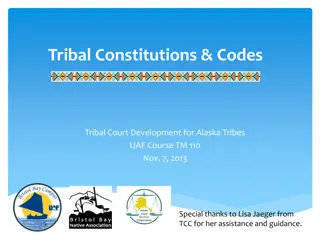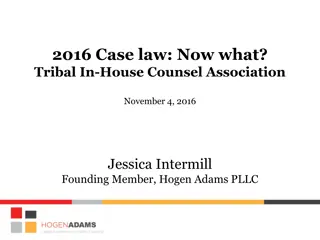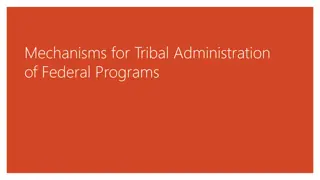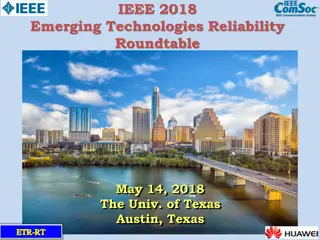Bureau of Safety and Environmental Enforcement Tribal Roundtable
The Bureau of Safety and Environmental Enforcement's Tribal Roundtable, led by Director Kevin Sligh, focuses on promoting safety, protecting the environment, and conserving offshore resources. The agenda includes discussions on carbon sequestration, oil spill response preparedness, renewable energy, and engagement with tribal members and the National Tribal Engagement Program (NTEP) staff. Participants learn how to navigate Zoom, introduce themselves, and engage in open discussions, culminating in closing remarks by Director Sligh.
Download Presentation

Please find below an Image/Link to download the presentation.
The content on the website is provided AS IS for your information and personal use only. It may not be sold, licensed, or shared on other websites without obtaining consent from the author. Download presentation by click this link. If you encounter any issues during the download, it is possible that the publisher has removed the file from their server.
E N D
Presentation Transcript
Directors Tribal Roundtable Kevin Sligh, Director Bureau of Safety and Environmental Enforcement June 26, 2023 Bureau of Safety and Environmental Enforcement Promoting Safety, Protecting the Environment and Conserving Offshore Resources 1
Welcome Introduction of Facilitator Meeting Logistics Agenda Review Opportunities for Input and Questions 2
How to navigate zoom Meeting Controls Toolbar Mute: Click Mute/Unmute on the meeting controls toolbar to control your microphone. Start Video: Click Start Video/Stop Video to show yourself. Participants: Click to see who is on the meeting. Chat: Click the text input box, then enter your message. Press Enter or click the send icon to send your message. Please add you name to your profile Raise your hand if you have a question 3 (Please identify yourself before speaking)
Agenda 1. Director Sligh Welcome and Opening Remarks 5. Carbon Sequestration Proposed Rule a. Tribal Discussion for Carbon Sequestration 2. Tribal Member Introductions 3. National Tribal Engagement Program (NTEP) Staff Introductions and Program Expansion a. Tribal Questions for NTEP Staff 6. Oil Spill Response Preparedness Proposed Rule a. Tribal Discussion for Oil Spill Response 7. Proposed Questions to Tribal Nations for Open Discussion 4. Renewable Energy and BSEE s New Authorities a. Tribal Discussion for Renewable Energy ************Break************ 8. Director Sligh Closing Remarks 4
WELCOME Director SLIGH's Opening Remarks 5
Tribal member Introductions Please say your Name, Tribe and Title If your Tribe is not listed please raise your hand at the end to introduce yourself. 6
National Tribal Engagement Program (NTEP) David Fish, Environmental Compliance Division Chief Bronia Ashford - Tribal Liaison Officer Jack Lorrigan - Alaska Regional Tribal Liaison Doug Jones - Gulf of Mexico Regional Tribal Liaison Sara Guiltinan Pacific Regional Tribal Liaison Jennifer "Gigi" Modrich - Eastern Seaboard Regional Tribal Liaison W. Shawn Arnold - Federal Preservation Officer 7
National Tribal Engagement Program (NTEP) Tribal Questions for NTEP Staff 8
Renewable Energy and BSEEs New Authorities AA003 Reorganization of Title 30 Renewable Energy and Alternate Uses of Existing Facilities on the Outer Continental Shelf Presenter: Michaela Noble,Regulatory Energy and Regulatory Compliance Program Director 9
Background BOEM and BSEE were formally established in 2011, as part of the reorganization of the Mineral Management Service BOEM retained all responsibility for renewable energy until an increase in activity justified the transfer of safety and environmental enforcement functions from BOEM to BSEE. BSEE did provide ongoing support to BOEM for renewable energy activities. In December 2020, the Principal Deputy ASLM began preparations to transfer safety and environmental compliance responsibilities from BOEM to BSEE. That transfer of authority was effectuated in September 2022, through revised chapters in the Departmental Manual. On January 31, 2023, BOEM/BSEE Split Rule formally transferred certain safety and environmental oversight, compliance, and enforcement regulations for the Department s Offshore Renewable Energy Program BOEM oversees 30 CFR 585, BSEE oversees 30 CFR 285 No substantive changes to the regulations. BOEM proposed substantive changes to renewable energy regulations, the Modernization Rule on January 30. Some included changes to the safety and enforcement authorities that now formally fall under BSEE. BSEE has been participating with BOEM in formal tribal consultation on the Modernization rule. 10
BOEM/BSEE Key offshore wind authorities BOEM Issuing and managing leases Environmental analyses BSEE Operational safety Environmental protection Site Assessment Plan Construction and Operations Plan (COP) General Activities Plan Facility Design Report (FDR) Fabrication and Installation Report (FIR) Safety Management System (SMS) Oil Spill Response Plan (OSRP) Emergency Response Plan (ERP) Decommissioning Enforcing BSEE regulations Financial Assurances Enforcing BOEM regulations 11
Overview of BOEM's and BSEE's Roles for Offshore Wind 12
Renewable Energy and BSEEs New Authorities Tribal Discussion for Renewable Energy 13
Break 14
AA04 Carbon Sequestration Rulemaking Kirk Malstrom Chief, Regulations & Standards Branch Office of Offshore Regulatory Programs BSEE 15
Background The Infrastructure Investment and Jobs Act (2021) amended Outer Continental Shelf Lands Act (OCSLA), authorizing DOI to administer leases, easement, and rights-of-way on the Outer Continental Shelf that provide for, support, or are directly related to the injection of a carbon dioxide stream into sub-seabed geologic formations for the purpose of long-term carbon sequestration. The law also requires DOI to promulgate regulations to carry out the OCSLA amendments. 16
Rulemaking Overview Joint Rulemaking Bureau of Safety and Environmental Enforcement (BSEE) Bureau of Ocean Energy Management (BOEM) Rulemaking Scope/Goal Ensure the transportation and sequestration of CO2 on the OCS is performed in a safe and environmentally responsible manner. Extensive Outreach on the Proposed Rule Industry, Domestic/International Regulators, Academia, NGOs, Tribes BSEE is evaluating existing CS-specific industry standards, CS programs and frameworks, and BSEE regulations for utilization and augmentation to CO2 operations on the OCS. 17
Rulemaking overview (cont.) Legacy Well Qualification Facility and Infrastructure Design and Installation wells, pipelines, platforms, etc. Injection/Monitoring Well Requirements Risk Assessment, Evaluation, Mitigation, and Monitoring Decommissioning/Site-Closure 18
Overview of the Carbon Sequestration program (BOEM) Lease approval and issuance: Lease process, site assessment, Site Characterization Plan, and Injection Operations Plan (consultation with BSEE for legacy wells and infrastructure) (BSEE) Lease activities : Carbon Sequestration Operations Plan (CSOP), Well Permitting (Applications for Permit to Drill and Applications for Permit to Modify), Pipeline/Platform/Facility/Measurement Permitting, Safety and Environmental Management Systems, and Injection operations (BOEM/BSEE) Plume modeling/monitoring, site closure, and decommissioning. 19
Carbon Sequestration Proposed Rule Tribal Discussion for Carbon Sequestration 20
Update to Oil Spill Response Plan Regulations for offshore facilities John Caplis Senior Environmental Protection Specialist Oil Spill Preparedness Division Bureau of Safety and Environmental Enforcement Promoting Safety, Protecting the Environment and Conserving Offshore Resources 21
Relationship Between Oil Spill Plans National Contingency Plan (NCP) Industry Oil Spill Response Plans (OSRPs) Area Contingency Plans (ACPs) Operator Response Organization Qualified Individuals Incident Management Team Incident Command Posts Interagency Response Organization Unified Command OSRPs must be consistent with the NCP and ACPs Area Oil Spill Risk Assessment Worst Case Discharge Scenarios Spill trajectory modeling Prioritization of Resources at Risk Environmental Sensitivity Maps Response Procedures Guidance on Response Strategies and Tactics Conditions for Use of Dispersants, In situ Burning, Mechanical Recovery Geographical Response Strategies Best Management Practices for Wildlife Contracted Oil Spill Equipment and Personnel 22
WHY are the regulations being revised? Oil spill response plan regulations (published in 1997) need updating to capture: Industry best practices and new uses of technology. Address changes in the National Response System (adoption of Incident Command System). Address gaps and recommended improvements contained in Deepwater Horizon After Action Reports . Address regulatory gaps identified through program administration over last two decades. Implement recommendations from 2018 DOI Office of the Inspector General Report. Incorporate guidance contained in Notices to Lessees (NTLs) from 2008 to 2013. 23
What actions are proposed for the rule? Since 2011, BSEE has conducted a series of research studies to support updating 30 CFR part 254 regulations to address improvements to oil spill preparedness. Develop Response System Calculators. Review Oil Spill Response Plan Response Equipment Capabilities. Study De Minimis Oil Volumes. 24
What are SOME Of the MOST Important proposed revisions? Streamline de minimis provisions. Improve incorporation of lessons learned. Align applicability to include offshore renewable energy facilities. Adopt new system metrics and calculators to better estimate oil removal capabilities of response equipment. Establish capability thresholds and response times for oil spill surveillance and tracking, mechanical recovery, dispersants, and in situ burning. Improve the quality of spill modeling for worst case discharge scenarios. Incorporate Incident Command System (ICS) requirements. Add enforcement provisions. 25
Are there potential economic impacts? Yes, but BSEE does not expect proposed rulemaking to have an economically significant impact on any affected parties. Are there potential Environmental impacts? Environmental impacts from proposed rulemaking are expected to be negligible. 26
Oil Spill Response Preparedness Proposed Rule Tribal Discussion for Oil Spill Response 27
Open Discussion Does your Tribe have any cultural, historical, and present day needs on or related to the Outer Continental Shelf that you would like to discuss? Do you have any questions or concerns beyond the topics already discussed today that you would like to bring up? Can you please recommend conferences or meetings that would be appropriate for Tribal Liaisons to attend that can help BSEE understand your issues or needs? 28
Contact information BSEE Website: BSEE Website: www.bsee.gov www.bsee.gov David Fish, Environmental Compliance Division Chief David.fish@bsee.gov @BSEEgov @BSEEgov BSEEgov BSEEgov A picture containing ax, tool, vector graphics Description automatically generated Michaela Noble,Regulatory Energy and Regulatory Compliance Program Director michaela.noble@bsee.gov Logo Description automatically generated Kirk Malstrom, Branch Chief Regulations and Standards kirk.malstrom@bsee.gov BroniaAshford - Tribal Liaison Officer bronia.ashford@bsee.gov Bureau of Safety and Bureau of Safety and Environmental Environmental Enforcement Enforcement W. Shawn Arnold - Federal Preservation Officer william.arnold@bsee.gov John Caplis, Oil Spill Preparedness Division john.caplis@bsee.gov Icon Description automatically generated BSEEgov BSEEgov National Tribal Engagement Program, tribalengagement@bsee.gov Bureau of Safety and Environmental Enforcement Promoting Safety, Protecting the Environment and Conserving Offshore Resources 30


